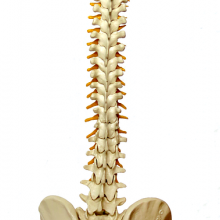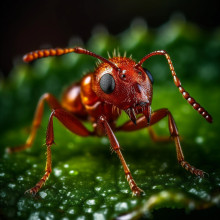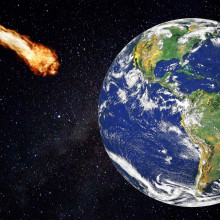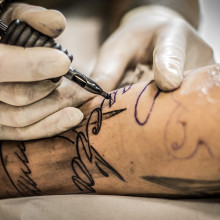This week on The Naked Scientists: A breakthrough in treating spinal cord injuries, worrying news about red fire ants in Sicily, we look at what it means for us in the UK. Plus, NASA is sending a sample of an asteroid back to Earth - it arrives this weekend; find out what scientists are hoping to learn. All that and more on this week's show...
In this episode

00:50 - Spinal injury treatment allows mice to walk again
Spinal injury treatment allows mice to walk again
Jordan Squair, EPFL
Chemical signals that can guide regrowing nerves disconnected by a spinal injury back towards their correct targets have been used by scientists in Switzerland to make paralysed mice walk again. Around the world, about half a million people are paralysed by spinal injuries each year; and unlike injuries to nerves elsewhere in the body, spinal cord and brain nerve cells do not spontaneously regenerate to bridge the injury. Part of the reason is that a dense scar forms at the injury site, which can prevent nerves from regrowing through it; but also, these regenerating nerves may not “know” where to grow to in order to repair and reconnect the damaged neurological wiring. But now EPFL researcher Jordan Squair and his colleagues have discovered how to bridge that scar tissue, and how to switch on a signalling molecule that acts like a homing beacon to draw regenerating nerve connections towards their correct targets. Paralysed mice treated with the experimental approach all began walking again. The team got the idea from how the nervous system develops in the embryo. It’s early days, but very exciting…
Jordan - Much of our work trying to regrow the spinal cord is based on development. It's based on the way that a human body would naturally develop. And when our nervous system starts coming into shape, there are a lot of molecules that will guide these different wires to go where they need to go. And one of the things that we've been able to figure out is one of those, call it a guidance queue. It's almost like a beacon that the wire should come over this direction and if we put that little beacon wherever we want, we can make the wires grow towards that. And that was really one of the biggest breakthroughs that we had because when we did that, we could tell them where to go. We don't have to rely on them kind of finding their way.
Chris - Talk us through the experiment then that showed that you could do that.
Jordan - A really big advance of this work, we managed to, if you think about this injury of the spinal cord, you think of it like a big scar that things can't get through. And what we managed to do before was to grow some wires through it, but nothing happened. We didn't see any improvement in walking. Every animal was still completely paralysed. And what we managed to do now was, because we figured out how to guide them, we figured out how to use these beacons to say, 'Hey, come over here.' We were able to grow things where they're supposed to grow. And when we did that, to our surprise, they all started walking again.
Chris - These are animals with injuries to their spinal cords.
Jordan - Yes.
Chris - When you say you put these beacons in, how do you do that and and where do you put the signals then, So that these disconnected nerves can see those beacons and moreover get guided by them?
Jordan - If you imagine a message starting out from your brain, and it's going to go from your brain, it's going to go down your spine and then it hits this block, this injury, this place it can't pass. Where we put these beacons is far below that and we put them little by little bit, almost like a breadcrumb trail so that the wires can keep finding them all the way along. And so what we're able to do with this is to guide these wires all the way down and they connect up with the part of the spinal cord that is going to allow you to walk.
Chris - What's the nature of the beacon signals and how do you get different bits of the spinal cord to produce them?
Jordan - What we did in these experiments is we used gene therapy. We're turning one gene on very highly, in a very specific place. The way that we do this in this work is we use viruses and so we deliver a virus into the spinal cord that creates this beacon of these, they're growth factors, to guide the wires where they need to go.
Chris - And does this work on all classes of nerve cells or are there different horses for different courses, as it were. You used different beacons to recruit and direct different classes of nerves because there are different types of nerves going both up and down the spinal cord, aren't there? Some carry sensory information, some carry movement information?
Jordan - Certainly. And we're just starting to understand how complex this is and how many different types there are. What we found in this is that there was actually a very specific kind of nerve that was going down that was very, very important for the recovery of walking. If you don't have this kind of nerve, you don't recover. And we were able to target it with this beacon. It has a way of recognising that beacon as what you would call a receptor. And so a big challenge moving forward is to catalogue all the different kinds of nerves that we have then to start to be able to regrow them where they need to go.
Chris - How do you make sure that the right nerve goes to the right place and makes the right connection and your arm signals don't end up moving your foot, for example?
Jordan - Yeah, it's a very long standing question and I think we haven't solved that here. To connect everything to the right spot is quite complicated. There's different theories about it and I think the one that I like the most that some people have shown quite nicely is that it might be that the nerves actually already know where to go. And so if we can get their wires into the right spot, they might already know who to connect to.
Chris - When you did this in your animals, I mean obviously a mouse and a rat is not a human being, but how dramatic was it and how successful was it? What was the sort of breakdown of the results?
Jordan - For us to start seeing this happen, it was really, really exciting and it was so impressive because it didn't happen overnight. It happened over the course of a couple of weeks. You started to see them move their legs and then after a couple of more weeks they started to walk again. It was a very natural process, which makes it all the more believable. It is not a magic bullet, it's not that we did something and all of a sudden, magic, everything was working. Every single mouse progressively regained the ability to walk over a period of time. That is very fitting with what we know about how long it would take.

Should embryo editing be legal?
A gene editing revolution is underway. Technologies like CRISPR Cas 9 give scientists the power to alter biology by removing, adding, or changing sections of DNA. The potential power of these tools is most apparent in medicine, where scientists have the ability to edit out the gene responsible for some incurable conditions so that carriers don’t pass them on to their children. Some scientists see the next step as performing gene editing on embryos before they’re implanted into their mothers, but this comes with a host of ethical concerns. Here’s a clip from a short film following the recent sitting of a Citizens' Jury set up to debate these very questions:
Juror - I might not live an incredibly long life and I believe in choice. However, does any severe morbidity in me and the length of my life determine its value or its richness? No.
While many are excited about embryo editing, any decision over its legality must be taken with careful thought: could we be paving the way to so-called ‘designer humans', setting in motion a slippery slide towards eugenics? Or perhaps we might damage ongoing efforts to understand and integrate people with rare genetic conditions into society?
The answers to these questions are not simple, but they can’t be ignored for much longer. In the search for answers, people with experience of living with genetic conditions, and their advocates, feel they aren’t always being listened to, as James Tytko reports…
Louise - Hi, I'm Louise. I am the mum of a child with a rare condition. He's incredibly lucky. His condition is treatable with medication and he's doing really well, but I felt that a lot of our journey to diagnosis and to find out what he had, it did feel like luck. And I think, in this day and age, there should be more choice for people, more understanding of what's happening to them and what they are passing on to their children. That's why I wanted to get involved in the Citizens' Jury.
James - A Citizens' Jury is a deliberative democracy exercise. It brings together people from diverse groups, as well as experts and deliberators, to discuss and debate issues with a view to making policy recommendations.
Sarah - These in-depth processes are brilliant at unlocking complex, knotty, moral issues where there are lots of different value judgments and there is a really wide range of views.
James - Sarah Castell, Chief Executive of Involve who facilitated the Citizens' Jury on embryo editing.
Sarah - They're often ones which give politicians a headache, where politicians say, 'I don't know what my remit to act is here. I don't know what the public genuinely want me to do because all of their views are so different.' There are some things where the way forward isn't clear and where you need to really have a deep reflection and bring out the nuances, and then come together and come up with a clear recommendation.
James - In late 2018, Chinese biophysicist He Jiankui shocked the world when he announced that twins had been born with a genome he had edited. An astonishing development, what he had done was also highly controversial and landed him a three year jail sentence. The procedure was risky and unsanctioned, and while the two children, Lula and Nana, are currently doing well, it's still unknown as to whether unwanted genetic changes might lead to health complications later down the line. One thing is for sure, though, Jiankui's procedure meant we couldn't put off difficult conversations about embryo editing for much longer. That was the feeling anyway of Professor Anna Middleton, a counsellor whose job is to help families make difficult decisions following genetic testing. While she was appalled that a scientist could take matters into his own hands in this way, bypassing the ethical process, she also recognised the power of embryo editing for the people she works with on a daily basis, those whose lives are impacted by genetic health conditions...
Anna - The key ethical issue is that we've made a moral distinction for some reason between treating somebody with an inherited condition through gene therapies and that being a good thing, and treating an embryo as a bad thing. And I would argue that if we are waiting for somebody to become ill before we treat them, why are we doing that when we could treat them earlier? And if we are thinking about treating them earlier in childhood, then why are we not doing it in utero? And if we're thinking about doing it in utero, why are we not thinking about doing it before we get to that point? Why aren't we just at least discussing the editing of human embryos to treat inherited disease for all future generations? Let's have a conversation about it.
James - But having this conversation, Anna feels, must hinge on a crucial component...
Anna - I feel increasingly frustrated that the people that are having conversations are the scientists, the clinicians, and the policy makers, and they are deciding on the behalf of others what good enough looks like. There really hasn't been broad public debate dialogue, and there definitely hasn't been concerted, joined together dialogue in patient communities. In the scientific conferences that I go to, there are just so many repeated calls for public dialogue, but nobody's actually doing it or knows how to do it well. And that's what we need: this joining up of really decent dialogue.
Will - I'm Will. I'm a granddad. I have an eight year old granddaughter with a very rare condition that's degenerative and life limiting. I didn't know what to expect of a Citizens' Jury. I don't think any of us did. But very early on we had a discussion about ground rules, that it was going to be a very safe space and that people would be respectful. And I think it's been patently obvious that the jury has become more than a jury. We are not just a group of individuals who met and went away. We've become, I think Michelle has used the word, a family. We argued probably like people do in families, but we look out for each other like people do in families. We're getting emotional again, but, I think it's that: we are not alone.
James - The jury ultimately voted in favour of asking the UK government to consider changing the law to allow genome editing of human embryos to treat serious genetic conditions. That's far from the end of the discussion though...
Michelle - Hello, I'm Michelle. I feel that the jury itself really wants to bring the recommendations into parliament. I think we could possibly set a precedent. We want to hear it for ourselves. We want ministers to be able to ask us directly, because I doubt that there's many times in their lives where they would've experienced people with lived experiences of rare conditions. So in order for this to take any traction and for it to make a difference, in order to create legislation that is going to be ethically sound, the only way for us to do that is to take the information from the jury and run with it.
Anna - I don't think we are ever going to reach a point where we have global consensus. We could do a million Citizens' Juries, we could do a million surveys, millions of workshops, we could involve every different community that's affected by this and I don't think we're ever going to agree. But what we can get to a point of is having a shared understanding of what the values are that we feel are really important and move from there. It's about bringing a real diversity of debate to the table and the Citizens' Jury is just a part of that. It's a piece of that.

17:01 - Invasive fire ants make landfall in Europe
Invasive fire ants make landfall in Europe
Mattia Menchetti, Instituto de Biología Evolutiva
Invasive and non native species play havoc with ecosystems and economies worldwide. In the UK alone, invasive are thought to cost us 4 billion pounds a year, because of things like forestry and agriculture. Therefore, keeping an eye on which organisms are entering where is a very important job. And there has now been some troubling news coming out of Sicily, as Will Tingle takes up the story...
Will - The red fire ant, Solenopsis invicta, is the fifth most costly invasive species in the world, costing global economies nearly $6 billion a year. Originating in South America, it has been on a colonising rampage across almost every continent for the past hundred years, save for Africa and Europe. But now that has changed as scientists have confirmed 88 nests on the small island of Syracuse in Sicily. I spoke to the Institute of Evolutionary Biology's Mattia Manchetti, about how far we think the ants have currently spread.
Mattia - So it's hard to say. For now we know that they are Sicily and they are in this spot and we don't really know the real extension. What we know is that this species has been there for at least probably four years, maybe even more. And this probably is not the first site of introduction because it's a very small marina. So it couldn't arrive there, it's impossible, or let's say it's unlikely that it arrived from the US or China. So that has to be somewhere, a place where it arrived first, maybe a big harbour or an airport. We don't know yet. So this is what we'll need to find out.
Will - The implication, therefore, is that these ants probably entered Europe somewhere else and made a separate journey to this island. Wherever that original point of access was, remains to be seen. But regardless, four years is seemingly a long time for these ants to exist and go relatively unnoticed on the island.
Mattia - Yes. And then maybe it can be even more, I would say. So we don't really know. Also the area can be much larger. It's hard to find such a small insect. They create big colonies, but there are not so many ant specialists in Europe. For the general public, these are just ants. Maybe they're more painful when they sting.
Will - And that sting is no joke. In fact, it is so potent. It can cause some children to go into anaphylactic shock. That's bad enough, but the problems don't end there.
Mattia - They cause a strong decline of general biodiversity of insects, invertebrates in general and even small vertebrates. And then we also had the economic problem of the species. They can damage electrical equipment, for example. Agricultural losses there are due to the presence of the species.
Will - These ants then cause medical, environmental, and economic havoc outside of their original habitat. So eradicating invasives is a notoriously difficult task. Just ask Florida about their Burmese pythons. So what is the plan to deal with these ants?
Mattia - This could be the next step for sure, trying to eradicate them, but it's gonna be very, very difficult to eradicate them. First because we don't know actually what is the real expansion of the embedded area. So this is, I think, the first step, understanding where they are and then the local authorities will try to eradicate them and then we'll see what is going to happen. Because there is long experience over eradication of the species and it's mostly come down to control. It's very hard to eradicate the species. New Zealand managed it three times actually, but it really will depend on the extension of the embedded area.
Will - New Zealand shows that there is hope, but this plan needs to start sooner rather than later because, as Southern Europe can surely attest after this summer, the temperature is rising. And the fire end favours the heat.
Mattia - Yes. So climate change is definitely helping new species, new alien species, to establish. It seems that climate change will definitely favour the Solenopsis invicta. So this is another aspect we have to keep in consideration when we are talking about climate change. Not only the direct impact, but what it favours. In this case, it may favour the establishment of the species in places where now it's not suitable.

21:19 - OSIRIS-REx to bring asteroid samples back to Earth
OSIRIS-REx to bring asteroid samples back to Earth
David Rothery, The Open University
This weekend an exciting mission that began 7 years ago and aims to return to Earth samples from a nearby asteroid should - if all goes to plan - come to fruition.
NASA are hoping that a capsule containing pristine samples harvested from the asteroid “Bennu” will plop down in the Utah desert. There are a few reasons for visiting this cosmic near neighbour, one being that next century it might well end up on a collision course with us meaning we might need to move it out of the way to avoid a potential impact. To do that, we need to know what it’s made of. But finding that out also opens a door on the earliest history of our solar system, and even the question of where we all came from. David Rothery is a planetary geologist at the Open University and has been following the mission keenly…
David - The mission is called Osiris-Rex. It launched seven years ago in September, 2016. It took two and a bit years to rendezvous with a small asteroid, a bit less than half a kilometre diameter called Bennu. They orbited it, chose somewhere to briefly touch down and grab some sample, and now that's been brought back to Earth. And as the spacecraft flies past the earth, the sample capsule is going be dropped off and will land in the desert somewhere in Utah while the spacecraft sails on to have a future rendezvous with another asteroid.
Chris - Oh wow. Which asteroid and where?
David - It's going to rendezvous with an asteroid called Apophis. It won't bring any sample back, but it will be able to do a good job with its rendezvous, hopefully going into orbit around the asteroid if there's enough fuel. You can learn an awful lot from orbiting these bodies: you can get the density pinned down because you know their size and their mass, and there's an x-ray spectrometer which gives you the elemental abundances. Now this has already been done at Bennu, so we've got a good map of Bennu's composition and we can see how variable it is. If it's the same, that's great. If it's different, we're learning even more. So whatever we learn from Apophis will be great on top of what we've learned from Bennu. But Bennu by then would have samples in the laboratory where we will be able to really take it apart piece by piece and understand the history and whether the building blocks for life are already there.
David - We think that Bennu is made of much the same stuff as the Winchcombe meteorite that people might remember. This landed in Winchcombe in the Cotswolds at the end of February, 2021 when we were all locked down, but it landed on somebody's drive and scientists were there very quickly and it was collected very quickly. It had travelled through the Earth's atmosphere, been on somebody's tarmac drive and some bits were in fields, so slightly contaminated. We're hoping to get at least 60 grams from Bennu. We won't know quite how much the spacecraft has collected until the return capsules are opened up. So it's going to be very exciting when we open these canisters and send them out to the laboratories for analysis.
Chris - Some of the headlines which have documented this mission have said that one of the reasons for going to Bennu is because this poses a threat because it's almost on a collision course with the earth. So we need to know what it's made of so we can work out if we have to blow it up or something. Was that just to get some headlines, is it more that it's interesting studying asteroids and that's the primary purpose of the mission? Or is there genuinely a threat here from this potential impactor?
David - I think Bennu was chosen for multiple reasons. Scientifically, it's very interesting because of its richness in carbon and therefore in organic molecules. Its shape is intriguing, it's spinning so fast, it's in the shape of a spinning top. But also, as you said, it's a potential threat to the Earth. Bennu's orbit crosses the Earth's orbit. One day, it could collide with the earth. Now this size, half a kilometre across, not much of it would survive passage through the Earth's atmosphere. It wouldn't break apart because it's a collection of boulders. It's not a solid lump, so you wouldn't be forming a major dinosaur killing impact on the earth. But we do need to know about the physical composition, mechanical composition of these things because if a bigger one heads our way, we would like to be able to divert it. If it's going to fall apart too easily, you might turn one crater forming impact into several crater forming impacts, which is perhaps the last thing that you want.
Chris - Presumably though, it can tell us useful chemical things because, if this has been out there for billions of years and is a vestige of what our solar system was made from, it must contain the interesting recipes of where we all came from?
David - Yes. And it probably has materials which were delivered to planets like the Earth which enabled life to get going. Now we don't say asteroids carry life, we say they carry the potential building blocks for life. And we'd like to look at these in Bennu in the samples that have come back totally uncontaminated in a sealed container. Those materials will be exactly as they were in space.
Chris - And what's involved in the actual landing and recovery? How are they actually going to do this?
David - The parent spacecraft will fly past Earth on the way to its next destination, but it will drop off a reentry capsule. There's a heat shield on it to slow it down, parachutes will deploy and eventually it'll hit the ground in Utah. But I'm not sure how fast. You wouldn't want to be an astronaut onboard a capsule like that. It'd be a fair old jolt. Hopefully it will not break open at all, it will still be a sealed container when taken to the laboratory.

Do tattoos stop sunburn?
Thanks to Julia Newton Bishop, professor of dermatology at the University of Leeds.
Julia - The top scaly layer of our skin is called the epidermis, which protects us from many different harmful things and is renewed constantly so that the tissue remains healthy. The epidermal stem cells are special cells within that skin, and they're replaced every four to six weeks. And the dead cells are shed as scale.
James - The stem cells themselves do self renew, but protecting these cells from damage is crucial in part to prevent them from becoming cancer cells.
Julia - In order to protect these special stem cells from sun damage, the epidermis may thicken up, for example, in people who work outside. But most of the protection results from pigment or melanin, which reduces the sunlight that gets through to the stem cells, which I found at the bottom layer of the epidermis.
James - In people with pale skin, there is less melanin and often a different type of melanin, red or brown in colour rather than black. And this means that there is more damaging energy from the sun reaching the stem cells in the bottom layer of the epidermis, and these cells are then more likely to get damaged and over time become cancerous. The other layer of our skin we have to note is the dermis.
Julia - The dermis lies below the epidermis and has many fewer cells, but is very important for the strength of the skin, is also the structure in which hair follicles, blood vessels, and essential stretches, such as nerves lie.
James - In this layer, you'll find the small muscles which make your hair stand on end in goose pimples and glands, which produce grease and sweat. Below the dermis is fat, fibrous tissue, and larger muscles.
Julia - Tattoo pigment lies in the dermis. That is the tattoo pigment lies below those critical stem cells of the epidermis, and therefore cannot protect them from sun damage, which is why tattoos cannot reduce the risk of skin cancer.
James - Thanks, Julia, and thanks to Cecilio for that thought provoking question. Next time we'll be tackling this question from listener Simon. He says, 'regularly on my car wing mirrors spider's webs form because of their tiny size, I'm wondering if they're able to cope with my car doing 70 miles per hour or do some get blown away? Is the force of the wind pulling them off the web easily overcome by their ability to stay attached to their webs?' Well, what an interesting question.
Related Content
- Previous Titans of Science: Robert Winston
- Next Is one apple a day enough?










Comments
Add a comment